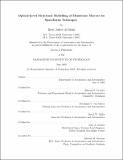| dc.contributor.advisor | Edward F. Crawley. | en_US |
| dc.contributor.author | De Blonk, Brett Jeffrey, 1971- | en_US |
| dc.contributor.other | Massachusetts Institute of Technology. Dept. of Aeronautics and Astronautics. | en_US |
| dc.date.accessioned | 2005-05-19T15:35:09Z | |
| dc.date.available | 2005-05-19T15:35:09Z | |
| dc.date.copyright | 2003 | en_US |
| dc.date.issued | 2003 | en_US |
| dc.identifier.uri | http://hdl.handle.net/1721.1/16996 | |
| dc.description | Thesis (Ph. D.)--Massachusetts Institute of Technology, Dept. of Aeronautics and Astronautics, 2003. | en_US |
| dc.description | Includes bibliographical references (p. 223-231). | en_US |
| dc.description | This electronic version was submitted by the student author. The certified thesis is available in the Institute Archives and Special Collections. | en_US |
| dc.description.abstract | The astronomy and Earth observation communities desire ever-larger space telescopes, but launch costs limit mass and technology limits size. Current research in large aperture mirrors largely supports deployed rigid optics, but efforts have already begun to develop technology that offers the possibility of a mass-optimal approach: a reflecting surface tens of microns thick over tens of meters in diameter. The manufacturing of membranes has advanced such that the community is just beginning to produce membranes with sufficient quality for optics, but the analysis of membranes is conducted with various models without verification of accuracy. Accurate structural modelling tools are required to create valid operational concepts, specify manufacturing tolerances, and define structural control needs. In the current work the accuracy of different membrane modelling tools is defined and quantified over a range of representative problems. Torsion-free, axisymmetric statics models are considered as a first step toward understanding three-dimensional dynamic behavior. An inverse solver is developed through a new approach to the geometrically-exact model, with initial and final shapes as model inputs and load distribution as output. The current approach opens the possibility of manufacturing-driven initial shapes and performance-driven final shapes. The inverse solver is used to establish a series of benchmark problems with geometries traceable to doubly-curved telescope mirrors. | en_US |
| dc.description.abstract | (cont.) Finite difference solutions to the benchmark problems lead to relationships between geometry, load, and model error; in the correlation with model error, geometry and load limits for optical-quality predictions are established for a set of models. | en_US |
| dc.description.statementofresponsibility | by Brett Jeffrey de Blonk. | en_US |
| dc.format.extent | 257 p. | en_US |
| dc.format.extent | 2957121 bytes | |
| dc.format.extent | 2956787 bytes | |
| dc.format.mimetype | application/pdf | |
| dc.format.mimetype | application/pdf | |
| dc.language.iso | eng | en_US |
| dc.publisher | Massachusetts Institute of Technology | en_US |
| dc.rights | M.I.T. theses are protected by copyright. They may be viewed from this source for any purpose, but reproduction or distribution in any format is prohibited without written permission. See provided URL for inquiries about permission. | en_US |
| dc.rights.uri | http://dspace.mit.edu/handle/1721.1/7582 | |
| dc.subject | Aeronautics and Astronautics. | en_US |
| dc.title | Optical-level structural modelling of membrane mirrors for spaceborne telescopes | en_US |
| dc.type | Thesis | en_US |
| dc.description.degree | Ph.D. | en_US |
| dc.contributor.department | Massachusetts Institute of Technology. Department of Aeronautics and Astronautics | |
| dc.identifier.oclc | 54091966 | en_US |
